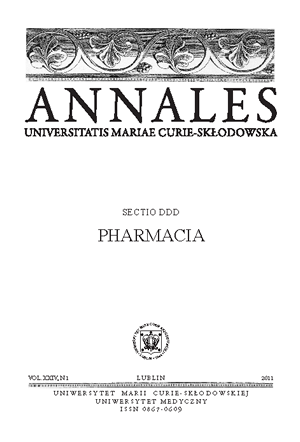Psychostimulant drugs – pharmacology and pharmacotherapy of addiction
Keywords:
psychostymulants, drug of abuse, addiction, amphetamine, cocaineAbstract
Currently, no effective pharmacotherapy for psychostimulant abuse has indicated efficacy for long-term use. A better understanding of the neuropharmacological effects of cocaine and related psychostimulants has supported efforts to develop and improve useful medications for psychostimulant abuse and dependence. Functional agonist treatments may be used effectively to stabilize neurochemistry, influence behaviour and lead to long-term abstinence. Similarly, medications that target glutamatergic and GABAergic function are reasonable candidates that have received significant attention, and some have demonstrated effectiveness in reducing cocaine use and enhancing cocaine abstinence. However, these encouraging results will require additional clinical studies in order to identify safe and efficacious pharmacotherapies. Pharmacological mechanisms that may underline stimulants dependence were presented in this article. Furthermore, advances in pharmacotherapy were discussed.
References
1. Amphetamine and methamphetamine emergency department visits, 1995-2002. The DAWN Report, July 2004. Accessed May 15, 2007.
2. Berridge C.W., Waterhouse B.D.: The locus coeruleus-noradrenergic system: modulation of behavioral state and state-dependent cognitive processes. Brain Res. Brain Res. Rev., 42, 33, 2003.
3. Berridge C.W.: Neural substrates of psychostimulant-induced arousal. Neuropsychopharm., 31, 2332, 2006.
4. Block S.D.: Assessing and managing depression in the terminally ill patient. ACP-ASIM End-of-Life Care Consensus Panel. American College of Physicians-American Society of Internal Medicine. Ann. Intern. Med., 132, 209, 2000.
5. Boutrel B., Koob G.F.: What keeps us awake: the neuropharmacology of stimulants and wakefulness-promoting medications. Sleep, 27, 1181, 2004.
6. Cornish J.L., Kalivas P.W.: Cocaine sensitization and craving: differing roles for dopamine and glutamate in the nucleus accumbens. J. Addict. Dis., 20, 43, 2001.
7. de Lima M.S., de Oliveira Soares B.G. : Pharmacological treatment of cocaine dependence: a systematic review. Addiction, 97, 931, 2002.
8. Evans S.M., Walsh S.L., Levin F.R. et al.: Effect of flupenthixol on subjective and cardiovascular responses to intravenous cocaine in humans. Drug Alcohol Depend., 64, 271, 2001.
9. Gock S.B., Skrinska V.A.: The use and abuse of psychostimulants. Clin. Eab. Sci., 18(2), 114, 2005.
10. Gonzalez G., Sevarino K., Sofuoglu M. et al.: Tiagabine increases cocaine-free urines in cocaine-dependent methadone-treated patients: results of a randomized pilot study. Addiction, 98, 1625, 2003.
11. Gorelick D.A.: Pharmacologic intervention for cocaine, crack, and other stimulant addiction. In: Graham A.W., Schultz T.K., Mayo-Smith M.F., Ries R.K., Wilford B.B. (eds): Principles of addiction medicine. Chevy Chase, MD American Society of Addiction Medicine, 3rd ed., 2003, p. 785-800.
12. Grabowski J., Rhoades H.: Risperidone for the treatment of cocaine dependence: randomized, double-blind trial. J. Clin. Psychopharmacol., 20, 305, 2000.
13. Grabowski J., Shearer J., Merrill J. et al.: Agonist-like, replacement pharmacotherapy for stimulant abuse and dependence. Addict. Behav., 29, 1439, 2004.
14. Hornung J.P.: The human raphe nuclei and the serotonergic system. J. Chem. Neuroanat., 26, 331, 2003.
15. Howard P., Shuster J., Twycross R. et al.: Psychostimulants. J. Pain Symptom Manage., 40 (5), 789, 2010.
16. Jupp B., Lawrence A.J.: New horizons for therapeutics in drug and alcohol abuse. Pharmacol. Ther., 125(1), 138, 2010.
17. Kalivas P.W., Stewart J.: Dopamine transmission in the initiation and expression of drug- and stress-induced sensitization of motor activity. Brain Res. Rev., 16, 223, 1991.
18. Marcovitch H.: Use of stimulants for attention deficit hyperactivity disorder: AGAINST. BMJ, 329(7471), 908, 2004.
19. Methamphetamine use, abuse, and dependence: 2002, 2003, and 2004. The NSDUH Report September 16, 2005. Accessed May 15, 2007.
20. Moore KA.: Amphetamine/sympathomimetic amines. In: Levine B (ed.): Principles of forensic toxicology. 2nd ed., AACC Press, Washington DC, 2003, p. 245-263.
21. Morton W.A., Stockton G.G.: Methylphenidate abuse and psychiatric side effects. Prim. Care Companion J. Clin. Psychiatry, 2, 159, 2000.
22. Petrakis I.L., Carroll K.M., Nich C. et al.: Disulfiram treatment for cocaine dependence in methadone-maintained opioid addicts. Addiction, 95, 219, 2000.
23. Rawson R.A., Huber A., McCann M. et al.: A comparison of contingency management and cognitive-behavioral approaches during methadone maintenance treatment for cocaine dependence. Arch. Gen. Psychiatry, 59, 817, 2002.
24. Riddle E.L., Fleckenstein A.E., Hanson G.R.: Role of monoamine transporters in mediating psychostimulant effects. AAPS J., 7(4), E847-851, 2005.
25. Self D.W., Barnhart W.J., Lehman D.A. et al.: Opposite modulation of cocaine-seeking behavior by D1-like and D2-like dopamine receptor agonists. Science, 271, 1586, 1996.
26. Shalev U., Grimm J.W., Shaham Y.: Neurobiology of relapse to heroin and cocaine seeking: a review. Pharmacol. Rev., 54,1, 2002.
27. Shoptaw S., Yang X., Rotheram-Fuller E.J. et al.: Randomized placebo-controlled trial of baclofen for cocaine dependence: preliminary effects for individuals with chronic patterns of cocaine use. J. Clin. Psychiatry, 64, 1440, 2003.
28. Soares B.G., Lima M.S., Reisser A.A. et al. : Dopamine agonists for cocaine dependence. Cochrane Database Syst. Rev., CD003352, 2003.
29. Sofuoglu M., Kosten T.R.: Novel approaches to the treatment of cocaine addiction. CNS Drugs, 19, 13, 2005.
30. Sulzer D., Sonders M.S., Poulsen N.W. et al.: Mechanisms of neurotransmitter release by amphetamines: a review. Prog. Neurobiol., 75, 406, 2005.
31. Volkow N.D.: Prediction of reinforcing responses to psychostimulants in humans by brain dopamine D2 receptor levels. Am. J. Psychiatry, 156, 1440, 1999.
32. Wilens T.E., Spencer T.J.: The stimulants revisited. Child Adolesc. Psychiatr. Clin. N. Am., 9, 573, 2000.
33. Wise R.A.: Dopamine, learning and motivation. Nat. Rev. Neurosci., 5, 483, 2004.
34. Xi Z.X., Gardner E.L.: Hypothesis-driven medication discovery for the treatment of psychostimulant addiction. Curr. Drug Abuse Rev., 1(3), 303, 2008.
Downloads
Published
Issue
Section
License
Copyright (c) 2011 Authors

This work is licensed under a Creative Commons Attribution-NonCommercial-NoDerivatives 3.0 Unported License.


